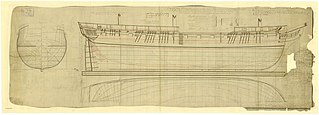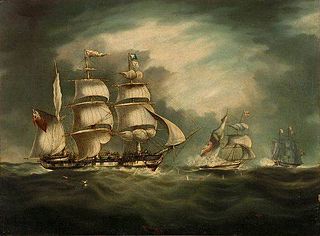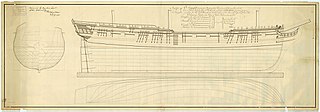
Nautilus was a schooner launched in 1799. The United States Navy purchased her in May 1803 and commissioned her USS Nautilus; she thus became the first ship to bear that name. She served in the First Barbary War. She was altered to a brigantine. The British captured Nautilus early in the War of 1812 and renamed her HMS Emulous. After her service with the Royal Navy, the Admiralty sold her in 1817.

HMS Belvidera was a Royal Navy 36-gun Apollo-class frigate built in Deptford in 1809. She saw action in the Napoleonic Wars and the War of 1812 and continued a busy career at sea into the middle of the 19th century. In 1846 she was reduced to harbour service, in 1860 she became a receiving ship, and she was finally disposed of in 1906.

HMS Pactolus was one of eight 38-gun Cydnus-class fifth-rate frigates of the Royal Navy, that served in the Napoleonic wars and the War of 1812. She was one of the warships that bombarded Stonington, Connecticut from 9 to 12 August 1814. Pactolus was paid off in August 1817 and sold in 1818.

Topaze was a Gloire-class 44-gun frigate of the French Navy. The British captured her in 1809 and she then served with the Royal Navy under the name Jewel, and later Alcmene until she was broken up in 1816.

HMS Havannah was a Royal Navy 36-gun fifth-rate frigate. She was launched in 1811 and was one of twenty-seven Apollo-class frigates. She was cut down to a 24-gun sixth rate in 1845, converted to a training ship in 1860, and sold for breaking up in 1905.

HMS Belle Poule was a Royal Navy fifth-rate frigate, formerly Belle Poule, a Virginie-class frigate of the French Navy that had been built by the Crucy family's shipyard at Basse-Indre to a design by Jacques-Noël Sané. She was launched on 17 April 1802, and saw active service in the East. In 1806 a British squadron under Sir John Borlase Warren captured her off La Palma in the Canary Islands. The Admiralty commissioned her into the Royal Navy as HMS Belle Poule. She was sold in 1816.
HMS Niemen was a Royal Navy 38-gun fifth-rate frigate. She began her career as the Niémen, a 44-gun French Navy Armide-class frigate, designed by Pierre Rolland. She was only in French service for a few months when in 1809 she encountered some British frigates. The British captured her and she continued in British service as Niemen. In British service she cruised in the Atlantic and North American waters, taking numerous small American prizes, some privateers but mostly merchantmen. She was broken up in 1815, at the end of the Napoleonic Wars and the War of 1812.
HMS Circe was a Royal Navy 32-gun fifth-rate frigate, built by Master Shipwright Joseph Tucker at Plymouth Dockyard, and launched in 1804. She served in the Caribbean during the Napoleonic Wars, and participated in an action and a campaign for which in 1847 in the Admiralty authorised the issuance of the Naval General Service Medal with clasps. The action, off the Pearl Rock, near Saint-Pierre, Martinique, was a debacle that cost Circe dearly. However, she also had some success in capturing privateers and a French brig. She was sold in 1814.

HMS Unicorn was a 32-gun fifth-rate Pallas-class frigate of the Royal Navy, launched in 1794 at Chatham. This frigate served in both the French Revolutionary Wars and the Napoleonic Wars, including a medal action early in her career. She was broken up in 1815.

HMS St Lawrence was a 14-gun schooner of the Royal Navy. She had been built in 1808 in St. Michaels, Talbot County, Maryland for Thomas Tennant and sold to Philadelphians in 1810. During the War of 1812 she was the US privateer Atlas. The UK captured her in 1813 and renamed her St Lawrence. The US privateer Chasseur recaptured her in 1815, and then HMS Acasta re-recaptured her.

Rhin was a 40-gun Virginie-class frigate of the French Navy launched in 1802. She was present at two major battles while in French service. The Royal Navy captured her in 1806. Thereafter Rhin served until 1815 capturing numerous vessels. After the end of the Napoleonic Wars she was laid up and then served as a hospital for many years. She was finally broken up in 1884.

Armide was a 40-gun frigate of the French Navy, lead ship of her class, and launched in 1804 at Rochefort. She served briefly in the French Navy before the Royal Navy captured her in 1806. She went on to serve in the Royal Navy until 1815 when she was broken up.
HMS Pilchard was a Royal Navy Ballahoo-class schooner of four 12-pounder carronades and a crew of 20. The prime contractor for the vessel was Goodrich & Co., in Bermuda. She was commissioned under Lieutenant Samuel Crew in May 1804, launched in 1805, and completed at Plymouth in 1806. Although Pilchard was often near naval engagements, she seems not to have had to fire her cannons before she was laid up in 1812. Entries in Lloyd's Register indicate that she continued in mercantile trade from at least 1817 until 1833, under a variety of owners and masters, and as far afield as Africa and Valparaiso.
During the French Revolutionary and Napoleonic Wars the British Royal Navy made use of hired armed vessels, one of which was His Majesty's hired armed cutter Nimrod. Three such vessels are recorded, but the descriptions of these vessels and the dates of their service are such that they may well represent one vessel under successive contracts. The vessel or vessels cruised, blockaded, carried despatches, and performed reconnaissance.

HMS Emulous was a Royal Navy 18-gun Cruizer-class brig-sloop, built by William Row at Newcastle and launched in 1806. She survived an inconclusive but bloody battle with a French frigate during the Napoleonic Wars and captured a number of prizes, including two privateers, on the Halifax station during the War of 1812 before she was wrecked in 1812.
HMS Challenger was a Cruizer-class brig-sloop launched at Redbridge, Southampton, in 1813. She participated in the capture of a French privateer and then sailed to the East Indies. She was laid up in 1819 and sold in 1824.

HMS Narcissus was the lead ship of the Royal Navy Narcissus-class 32-gun fifth-rate frigate, launched in 1801. She participated in the War of 1812.
HMS Barbadoes was a 16-gun vessel, the American Herald, captured in 1813. The Royal Navy took her into service as HMS Barbadoes She captured a number of merchantmen and privateers before she was paid-off in May 1816. In 1814–1815 she also captured three Spanish and French vessels carrying over 1100 slaves. Barbadoes became a powder ship in Jamaica that was later wrecked with her remains being sold.
HMS Growler was a Archer-class gun-brig built for the British Royal Navy and launched in 1804. She captured several French privateers and one Danish privateer, and took part in two actions that earned her crew the Naval General Service Medal (NGSM). She was sold in 1815.
HMS Conflict was launched in 1805. She captured a number of vessels, including privateers, and participated in several major actions. She disappeared in November 1810 with the loss of all her crew.













